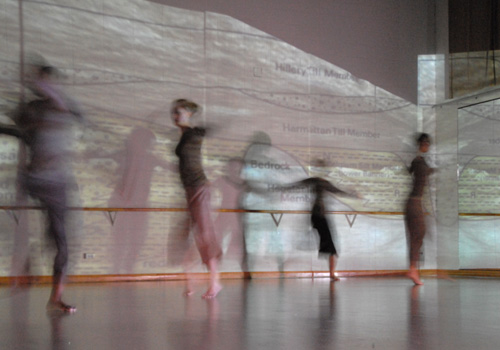How to dance like water: Go with the flow
November 19, 2008
Dancing isn’t always something done on a stage, in a bar or at a ballet.
For Jennifer Monson, a dance professor at the University, dance and human movement are an embodiment of the unknowable parts of natural phenomena, and her projects represent our connection to the natural world that surrounds us.
Monson’s first major undertaking at the University, “Mahomet Aquifer Project,” was presented last Thursday through Saturday as part of the “Reimagining the Proscenium” program at the Krannert Center for the Performing Arts in Urbana. A proscenium is the area of the stage that the audience can see – the space between the curtain and the audience.
The program featured faculty productions in non-traditional presentation spaces throughout Krannert, such as hallways and basements.
“Mahomet Aquifer Project,” choreographed and produced by Monson, focused on the underground water source that provides Champaign, Urbana and the surrounding area with its water. Audience members, led through the center in groups of 15, watched as members of the sophomore dance studio moved throughout the building, depicting the flow of the aquifer’s water.
Get The Daily Illini in your inbox!
“(The aquifer) is vastly interesting to me … the water is over 25,000 years old, and we’re over 80 percent water, so we’re a part of the aquifer itself,” Monson said.
The transformation from underground water source to dance presentation is one that requires looking inside our own bodies, she said. From our blood and lymph nodes to our nervous system, everything is flowing inside of us much as water flows through creeks and treatment plants. The key is transforming the concept of flow into human movement, Monson said.
“I think of the skeleton as the bedrock, with tissue flowing around it,” she said. “The artistic process is very intuitive … water evokes a lot of emotions in most people, from nostalgia to an idealized view of nature.”
Though boring to some, Monson finds Central Illinois’ natural environment a fascinating template. Its highly managed nature, a result of centuries of industrial-scale farming, ethanol production and use of natural resources, such as the Mahomet Aquifer, exemplify the effects of human interaction with their environments, she said. Her interest in nature and humans’ interaction with it took root during her childhood in the high desert of southern California.
“Appreciation of these environments was part of my upbringing. The large, unknowable phenomena that nobody really understands is just fascinating to me,” she said.
Monson came to Champaign in January as part of a cluster hire by the University’s Environmental Council, which aims to raise awareness of environmental concerns in the campus community. The program aimed to bring in experts in various fields, such as geology, natural resources and history, she said.
“I was just thrilled that they would include the arts … it was very meaningful to me and shows a lot of innovation on the part of the University,” Monson said.
Before coming to Illinois, Monson spent several years in New York City, where she produced another major nature-inspired dance project, “Bird Brain.” This project focused on bird migration patterns, interpreted as dance.
“I got the idea all at once, seeing the patterns of pigeons and bird migration in the city,” Monson said. “It completely transformed my life and helped me feel more a part of my world, which I love sharing with others.”
For both “Bird Brain” and “Mahomet Aquifer Project,” research and consultation with scientists was critical. Monson’s own background research was combined with their knowledge, resulting in a fuller understanding of the issues at hand, she said.
Still, “Mahomet Aquifer Project” is a work in progress, and last weekend’s presentation is simply the first installment of a larger series Monson plans to continue until at least 2010.
“I want to give the audience an autonomous and less passive experience,” Monson said. “I wasn’t very interested in returning to the proscenium. I want to re-imagine it and fill it in a different way.”







